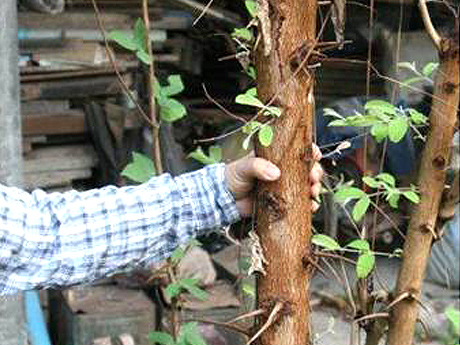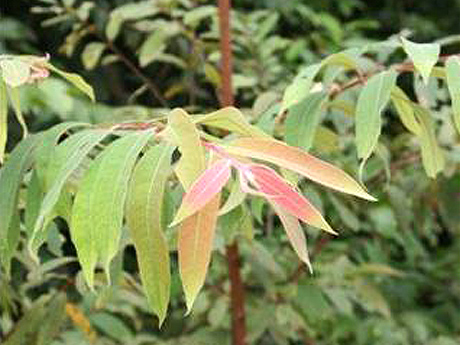Mai tiew white charcoal


Source plants
- scientific name
- Cratoxylum cochinchinense
Cratoxylum formosum
Cratoxylum pruniflorum - general name
- Mai tiew
- overview
-
Mai tiew is a generic term to refer to Cratoxylum cochinchinense and Cratoxylum formosum, which belong to the genus Cratoxylum in the family Hypericaceae and its subspecies, Cratoxylum pruniflorum in Lao, the indigenous language of Laos.
The genus Cratoxylum in Southeast Asia is divided into two groups in the timber trade: Geronggang, which is comparatively lighter and Derum, which is relatively heavier. Geronggang is suitable as a raw material for particle boards and pulp and a subject of trade, but Derum is rarer and considered not subject to commercial trading. Both are used as building materials by local residents and also as wood for firewood and charcoal.
Mai tiew, classified as Derum, is a tree that is widely distributed in Southeast Asia and grows to a height of 30-40m and a diameter of 50-60cm. Its young leaves are pink and flowers white or reddish pink, sometimes purple, with six petals. It appears in riverside forests as well as grassland and slopes.
In Laos, mai tiew grows actively on sunny, dry slopes, and it can be coppiced by methods such as root sucker regeneration. In places where mai tiew grows quickly, its root diameter becomes 5-10 cm in approximately five years and it can be expected to be used for charcoal. Cratoxylum pruniflorum, whose root has clusters of hard thorns, is primarily used for that purpose.
Product characteristics
- use
- Firewood, charcoal, garden tree
- area
- Myanmar, southern China, Vietnam, Cambodia, Thailand, Laos, Peninsular Malaysia, Indonesia
- overview
-
Mai tiew white charcoal has weaker calorific value compared to domestic white charcoal, etc. However, the volatility is lower than other foreign white charcoal. Charcoal cracks when water or volatile constituents contained in it explode and charcoal splinters may cause injury. Also, mai tiew white charcoal is relatively inexpensive.
Production trends of white charcoal in Japan
The production of charcoal in Japan is on a downward trend over the long term due to aging of charcoal burners and shortage of raw timber.
The production of white charcoal decreased to 3,215 tons in 2013 (85%) from 3,779 tons in 2005 (100%). Of the production in 2013, that of three prefectures, Wakayama, Kochi, and Miyazaki, constitutes 85%.
The production of black charcoal decreased significantly to 8,004 tons in 2013 (55%) from 14,476 tons (100%) in 2005. Of the production in 2013, that of Iwate and Hokkaido Prefectures constitutes 64%, but the producing areas are not concentrated unlike white charcoal.Import trends of white and black charcoals (natural charcoals) in Japan
Import of white and black charcoal in Japan remains unchanged or is on a decreasing trend in recent years, but the import sources have changed drastically. Import from China, which had been a supplier, decreased significantly from 21,805 tons (100%) in 2008 to 6,950 tons (32%) in 2014 as the country imposed a trade embargo on charcoal produced from natural wood in 2004 and 2005, and strengthened its export controls in and after 2010. As a result, import of charcoal from Southeast Asia increased. Especially, import of mai tiew white charcoal from Laos as an alternative to Chinese white charcoal grew by eight times from 774 tons (100%) in 2008 to 6,267 tons (810%) in 2015.
Note) Import of charcoal is the total amount of black and white charcoal according to Trade Statistics of Japan by Ministry of Finance, but it is expected that charcoal from Laos is mostly white charcoal based on importers’ information.
Import of eucalyptus white charcoal has been attempted but has not fully progressed due to aspects such as volatility, heating power, odor, stable supply, and price.
Demand trends of white charcoal in Japan
- Consumers
The main consumers of white charcoal include restaurants using charcoal, such as those serving grilled chicken and eel, and can be classified as follows.- Restaurants where kitchen staff are not familiar with using charcoal prefer mai tiew white charcoal which lacks volatility as they do not need much heating power.
- Restaurants which are familiar with using charcoal prefer domestic charcoal as well as charcoal produced with natural wood grown in China and charcoal from wood briquettes,which have strong heating power.
- Restaurants which attach importance to the brand image use domestic products.
- Price
Prices of white charcoal differ greatly depending on areas of production. According to an article in a charcoal trade paper, if ubame oak white charcoal produced in Wakayama is 100, Chinese white charcoal is 49, Lao mai tiew white charcoal 36, and Vietnamese eucalyptus charcoal 35. The price of imported white charcoal is one-third to half of that of domestic product. - Outlook
For white charcoal, demand is segregated to some extent and mai tiew is not yet known well in the Japanese market. Combined with the slowdown in the demand for Chinese white charcoal, the demand for mai tiew can be expected to increase going forward.
Future prospects and issues to be addressed
There is little demand for white charcoal in developing countries including China, and, for the time being, Japan and South Korea are the main importers. While constant demand is expected in Japan and Korea, the production of white charcoal is on a decreasing trend both in Japan and China. It needs to be examined whether mai tiew white charcoal can continue to be used as an alternative material in a stable manner in the future.
In Laos, mai tiew trees are grown by farmers and mai tiew white charcoal is produced by Lao and Chinese companies according to Lao laws and regulations with organizations such as villages and forest bureaus in charge of licensing and other procedures. However, establishment of a structure where public and private relevant parties share information on sustainable production of mai tiew white charcoal and buckle down to work, looking into the future, has not been progressed. Especially, measures are not taken towards methods to grasp and secure supplies of raw timber. It is necessary to review the cultivation and securing methods and contribute to the promotion of sustainable forest management, in cooperation with farmers.
- Consumers
- references
-
-
Major Commercial timbers p143-p150
- 平成27年度 途上国持続可能な森林経営推進事業 事業化可能性調査
マイ・テュー白炭 報告書(平成28年1月)株式会社 恵山通商 - 財務省 貿易統計
- 農林水産省 特用林産物統計調査
http://www.maff.go.jp/j/tokei/kouhyou/tokuyo_rinsan/index.html - 海外の森林と林業 No80(2011)「ラオス産木炭、特にマイテュー白炭について」
圓谷浩之(公財)国際緑化推進センター - ラオス国別援助検討会報告書 1998 国際協力事業団
- 平成27年度 途上国持続可能な森林経営推進事業 事業化可能性調査


